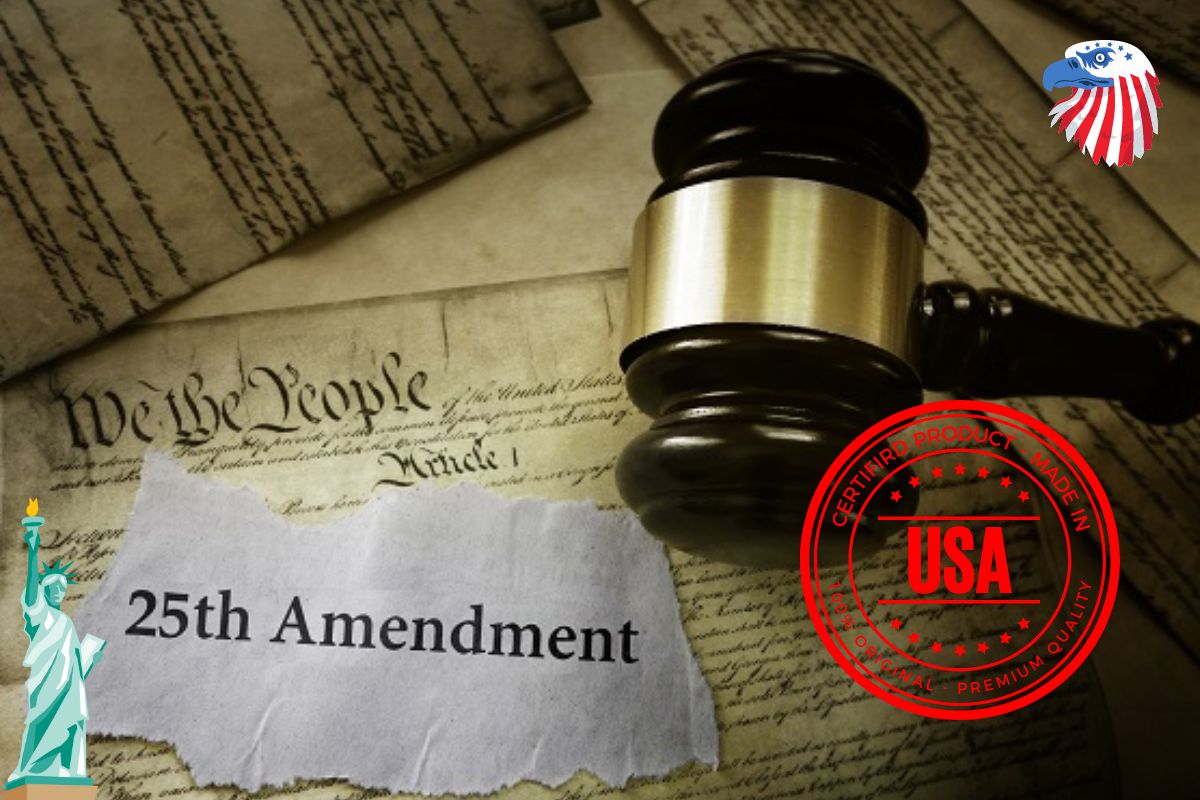The 25th Amendment (Amendment XXV) to the United States Constitution states that if the President is unable to perform his or her duties, the Vice President becomes President (Section 1) or Acting President (Sections 3 or 4).
This is possible if the President is just unwell or disabled for a short period of time. It may also occur until the end of the President’s term (time in office) if the President dies, resigns, or is “unable to discharge the powers and duties of his office”.
The Twenty-fifth Amendment further specifies what happens if there is a “vacancy” in the Vice President’s office. The states ratified the Amendment, which became part of the United States Constitution on February 10, 1967.
What is the 25th Amendment?
This means that if the President is dismissed, dies, resigns, or is unable “to discharge [their] powers and duties” (i.e., unable to do the tasks a President is required to do), the Vice President will take over their position.
The Vice President will perform the President’s duties until they recover (if they are simply sick or disabled) or until the next Presidential election (if the President resigns or dies).
If neither the President nor the Vice President are capable of carrying out the President’s duties, Congress has the authority to determine who will. This is all the Constitution says about the matter.
In 1841, William Henry Harrison, the ninth President of the United States, became the first President to die in office. Previously, Representative John Williams proposed that if the President died, the Vice President take over as Acting President.

Proposals
Members of Congress suggested two different amendments to fill in the details missing from Clause 6.
Keating-Kefauver Proposal: proposed that Congress pass legislation determining who should make decisions when a President becomes disabled. It was suggested in 1963 by Senator Kenneth Keating of New York and supported by Tennessee Senator Estes Kefauver. Other Senators, however, were concerned that Congress would abuse this power or fail to enact the law after the amendment was ratified.
Bayh-Celler Proposal: eventually became the Twenty-fifth Amendment. On January 6, 1965, Senator Birch Bayh offered the amendment in the United States Senate, and Representative Emanuel Celler (Chairman of the House Judiciary Committee) proposed it in the United States House of Representatives. Unlike the Keating-Kefauver proposal, it offered a means to fill the Vice President’s seat if it was vacant, as well as set out rules for how a President could be declared “disabled.
On February 19, 1965, the Senate approved the amendment. However, the House enacted a different version of the amendment on April 13th. The House and Senate had to organize committees to work out a version of the amendment that everyone could agree on. On July 6, 1965, both houses of Congress approved the final form of the amendment and sent it to the states for ratification.
Ratification
The Twenty-fifth Amendment, like all other constitutional amendments proposed by Congress, required ratification by three-fourths of the states (38 out of 50). Ratification was completed 19 months after the amendment was introduced. Another nine states later ratified the Amendment; three states did not vote to ratify it.
The states ratified the Amendment in this order
| Order | State | Date | Order | State | Date | |
|---|---|---|---|---|---|---|
| 1 | Nebraska | July 12, 1965 | 2 | Wisconsin | July 13, 1965 | |
| 3 | Oklahoma | July 16, 1965 | 4 | Massachusetts | August 9, 1965 | |
| 5 | Pennsylvania | August 18, 1965 | 6 | Kentucky | September 15, 1965 | |
| 7 | Arizona | September 22, 1965 | 8 | Michigan | October 5, 1965 | |
| 9 | Indiana | October 20, 1965 | 10 | California | October 21, 1965 | |
| 11 | Arkansas | November 4, 1965 | 12 | New Jersey | November 29, 1965 | |
| 13 | Delaware | December 7, 1965 | 14 | Utah | January 17, 1966 | |
| 15 | West Virginia | January 20, 1966 | 16 | Maine | January 24, 1966 | |
| 17 | Rhode Island | January 28, 1966 | 18 | Colorado | February 3, 1966 | |
| 19 | New Mexico | February 3, 1966 | 20 | Kansas | February 8, 1966 | |
| 21 | Vermont | February 10, 1966 | 22 | Alaska | February 18, 1966 | |
| 23 | Idaho | March 2, 1966 | 24 | Hawaii | March 3, 1966 | |
| 25 | Virginia | March 8, 1966 | 26 | Mississippi | March 10, 1966 | |
| 27 | New York | March 14, 1966 | 28 | Maryland | March 23, 1966 | |
| 29 | Missouri | March 30, 1966 | 30 | New Hampshire | June 13, 1966 | |
| 31 | Louisiana | July 5, 1966 | 32 | Tennessee | January 12, 1967 | |
| 33 | Wyoming | January 25, 1967 | 34 | Washington | January 26, 1967 | |
| 35 | Iowa | January 26, 1967 | 36 | Oregon | February 2, 1967 | |
| 37 | Minnesota | February 10, 1967 | 38 | Nevada | February 10, 1967 | |
| Amendment added to Constitution: February 10, 1967 | ||||||
| 39 | Connecticut | February 14, 1967 | 40 | Montana | February 15, 1967 | |
| 41 | South Dakota | March 6, 1967 | 42 | Ohio | March 7, 1967 | |
| 43 | Alabama | March 14, 1967 | 44 | North Carolina | March 22, 1967 | |
| 45 | Illinois | March 22, 1967 | 46 | Texas | April 25, 1967 | |
| 47 | Florida | May 25, 1967 | ||||
| States That Did Not Ratify the Amendment | ||||||
| North Dakota | Georgia | |||||
| South Carolina | ||||||
Presidential Disability and Succession
Section 1
If the President is removed from office, dies, or resigns, the Vice President assumes the presidency.
Section 2
When there is a vacancy in the office of Vice President, the President shall designate a Vice President, who shall assume office after being confirmed by a majority vote of both houses of Congress.
Section 3
Whenever the President transmits a written declaration to the President pro tempore of the Senate and the Speaker of the House of Representatives that he is unable to discharge the powers and duties of his office, and until he transmits a written declaration to the contrary, the Vice President serves as Acting President.
Section 4
When the Vice President and a majority of the principal officers of the executive departments or such other body as Congress may by law provide transmit a written declaration to the President pro tempore of the Senate and the Speaker of the House of Representatives that the President is unable to discharge the powers and duties of his office, the Vice President shall immediately assume the powers and duties of the office as Acting President.
After transmitting his written declaration that no inability exists to the President pro tempore of the Senate and the Speaker of the House of Representatives, the President shall resume his powers and duties unless the Vice President and a majority of either the principal officers of the executive department or of such other body as Congress may by law provide transmit within four days to the President pro tempore of the Senate and the Speaker. Thereupon, Congress shall decide the problem.
If the meeting is not in session, it must be held within 48 hours. If Congress determines by two-thirds vote of both Houses within twenty-one days of receiving the latter written declaration, or within twenty-one days of Congress being required to assemble, that the President is unable to discharge the powers and duties of his office, the Vice President shall continue to do so as Acting President; otherwise, the President shall resume the powers and duties of his office.
Source
Wikipedia

Mike Neon is a seasoned journalist specializing in United States news, known for his comprehensive coverage of national affairs and current events. With a career spanning 5 years in journalism, Mike has established himself as a reliable source of accurate and insightful reporting. His articles delve deep into political developments, social issues, and cultural trends shaping the United States today. Mike Neon’s dedication to providing balanced perspectives and in-depth analysis ensures that readers stay informed about the latest developments that impact the nation.







